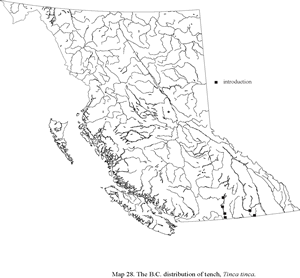Dorsal spines (total): 4; Dorsal soft rays (total): 8 - 9; Anal spines: 3 - 4; Anal soft rays: 6 - 8; Vertebrae: 39 - 41. Body thickset, heavy, and laterally compressed, the caudal peduncle characteristically deep and short. Skin thickened, slimy; the scales small, embedded. Overall coloration olive-green, at times dark green or almost black, with golden reflections on ventral surface. Head triangular, eye orange-red, small; snout relatively long; interorbital broad; mouth terminal, small in size with thick lips and a pair of well-developed barbels, one at each corner of the mouth. Caudal fin with 19 rays.
Tench
Family: Cyprinidae
Introduction
|
Species Information
Biology
|
Distribution
|
BC Distribution and Notes Osoyoos, Christina, Skaha, and Okanagan lakes plus a few small lakes in the Okanagan (several of which were "rehabilitated" (poisoned) in the 1950s and 1960s). They also occur in the reservoirs in the Pend d'Orielle system near Trail. Source: Information provided by Don McPhail for E-Fauna BC. Global Distribution Eurasia: all of Europe, including the British Isles. Arctic Ocean drainage, Ob and Yenisei basins, and rarely in Lake Baikal. Source: FishBase. Kottelat, M. 1997 European freshwater fishes. Biologia 52, Suppl. 5:1-271. |
Status Information
|
BC Ministry of Environment: BC Species and Ecosystems Explorer--the authoritative source for conservation information in British Columbia. |
Synonyms and Alternate Names
Cyprinus nca Linnaeus, 1758 Cyprinus tincaauratus Bloch, 1792 Cyprinus tincaurea Shaw, 1804 |
